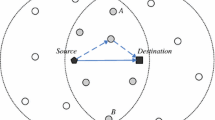Abstract
Relay selection, also called opportunistic relay, is capable of fast narrowing the search scope, finding the optimal relays and achieving a better cooperative transmission. With the continuous expansion of network capacity, the coverage area and the participating relays, it is unwise to traverse all the nodes to select the best relay. An optimal scheme based on cognitive wireless multi-hop relay selection has been proposed in this study, in which a threshold value is set for the signal-to-interference-plus-noise ratio (SINR). Only when the SINR exceeds the threshold can the node be selected as the relay node. Because of the random distribution and geographical universality of the relay, the candidate relays would better be limited within a particular area. Then a model based on stochastic geometry is established to rapidly find the relay which meets the demand near optimally, without needing of the global channel state information of the network in advance. The simulation results show that the optimized scheme can reduce the searching time and improve the performance of the secondary transmission. In addition, theoretical formula of the outage probability and channel data transmission rate has also been derived and verified its effectiveness through simulation.






Similar content being viewed by others
References
Ibrahim AS, Sadek AK, Su W, Liu KJR (2008) Cooperative communications with relay-selection: when to cooperate and whom to cooperate with? IEEE Trans Wirel Commun 7(7):2814–2827
Bletsas A, Khisti A, Reed DP, Lippman A (2005) A simple cooperative diversity method based on network path selection. IEEE J Sel Areas Commun 24(3):659–672
Xu L (2012) Relay selection and cooperative resource allocation in cognitive cooperative wireless networks. Shandong University, Jinan
Zhao Y, Adve R, Lim TJ (2006) Improving amplify-and-forward relay networks: optimal power allocation versus selection. In: 2006 IEEE International Symposium on Information Theory. IEEE, pp 1234–1238
Shah V, Mehta NB, Yim R (2010) Splitting algorithms for fast relay selection: generalizations, analysis, and a unified view. IEEE Trans Wirel Commun 9(4):1525–1535
Chen CF, Fang WH, Lang HS (2012) Joint relay selection, bandwidth allocation and power distribution via genetic algorithm in multi-user decode-and-forward relay networks. In: 2012 International Symposium on Intelligent Signal Processing and Communications Systems. IEEE, pp 124–129
Ikki SS, Ahmed MH (2010) On the performance of cooperative-diversity networks with the Nth best-relay selection scheme. IEEE Trans Commun 58(11):3062–3069
Zou Y, Zhu J, Zheng B, Yao YD (2010) An adaptive cooperation diversity scheme with best-relay selection in cognitive radio networks. IEEE Trans Signal Process 58(10):5438–5445
Bletsas A, Shin H, Win MZ (2007) Cooperative communications with outage-optimal opportunistic relaying. IEEE Trans Wirel Commun 6(9):3450–3460
Song L (2011) Relay selection for two-way relaying with amplify-and-forward protocols. IEEE Trans Veh Technol 60(4):1954–1959
Eqbhal M, Nagabhooshanam E (2018) Design of efficient queuing system in cooperative wireless diversity networks for high speed data transmission applications. IEEE Design of Efficient Queuing System in Cooperative Wireless Diversity Networks for High Speed Data Transmission Applications, 1–6
Ding H, Ge J, da Costa DB, Jiang Z (2010) Asymptotic analysis of cooperative diversity systems with relay selection in a spectrum-sharing scenario. IEEE Trans Veh Technol 60(2):457–472
Ng DWK, Lo ES, Schober R (2012) Dynamic resource allocation in MIMO-OFDMA systems with full-duplex and hybrid relaying. IEEE Trans Commun 60(5):1291–1304
Mousavifar SA, Khattab T, Hasna M (2010) Sequential random selection relaying for energy efficient wireless sensor networks. In: 2010 IEEE Global Telecommunications Conference GLOBECOM 2010. IEEE, pp 1–6
Chen Y, Fang X, Huang B (2014) Energy-efficient relay selection and resource allocation in nonregenerative relay OFDMA systems. IEEE Trans Veh Technol 63(8):3689–3699
Mousavifar SA, Leung C, Khattab T (2009) Lifetime maximization for greedy selective relay strategies. In: 2009 5th IEEE GCC Conference & Exhibition. IEEE, pp 1–6
Zuo F, Dong M (2012) Energy-aware relay selection for multiuser relay networks. In: 2012 IEEE International Conference on Communications (ICC). IEEE, pp 4621–4625
Lo CK, Vishwanath S, Heath RW (2008) Relay subset selection in wireless networks using partial decode-and-forward transmission. IEEE Trans Veh Technol 58(2):692–704
Li B, Li H, Wang W, Hu Z, Yin Q (2013) Energy-effective relay selection by utilizing spacial diversity for random wireless sensor networks. IEEE Commun Lett 17(10):1972–1975
Michalopoulos DS, Karagiannidis GK (2008) PHY-layer fairness in amplify and forward cooperative diversity systems. IEEE Trans Wirel Commun 7(3):1073–1082
Joung J, Sayed AH (2010) Multiuser two-way amplify-and-forward relay processing and power control methods for beamforming systems. IEEE Trans Signal Process 58(3):1833
Lu X, Zheng J, Liu C, Xiao J (2017) A mobility and activeness aware relay selection algorithm for multi-hop D2D communication underlaying cellular networks. In: 2017 IEEE International Conference on Communications (ICC). IEEE, pp 1–6
Sun H, Naraghi-Pour M (2017) Hop-by-hop relay selection strategy for multi-hop relay networks with imperfect CSI. IET Commun 11(9):1387–1395
Song W, Zeng F, Hu J, Wang Z, Mao X (2017) An unsupervised-learning-based method for Multi-hop wireless broadcast relay selection in urban vehicular networks. In: 2017 IEEE 85th Vehicular Technology Conference (VTC Spring). IEEE, pp 1–5
Ying B, Nayak A (2018) A power-efficient and social-aware relay selection method for multi-hop D2D communications. IEEE Commun Lett 22(7):1450–1453
Author information
Authors and Affiliations
Corresponding author
Additional information
Publisher's Note
Springer Nature remains neutral with regard to jurisdictional claims in published maps and institutional affiliations.
Rights and permissions
About this article
Cite this article
Wang, Zx., Dong, Yf. & Bao, Zk. Optimal algorithm for Multi-hop relay selection based on cognitive radio. J Supercomput 76, 6515–6531 (2020). https://doi.org/10.1007/s11227-019-03077-0
Published:
Issue Date:
DOI: https://doi.org/10.1007/s11227-019-03077-0




